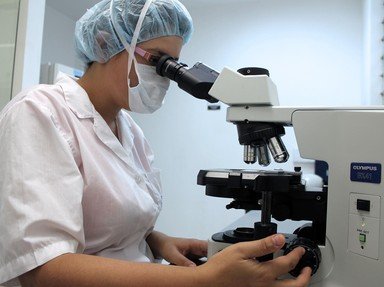Quiz Answer Key and Fun Facts
1. In a cell, a gene codes for a nucleic acid known as mRNA, and mRNA codes for proteins. Just four nucleotides can combine to code for twenty amino acids. Which molecular components function to both "read" the mRNA code and assemble the amino acids into a protein/polypeptide?
2. Amino acids are the "building blocks of proteins" and the sequence of amino acids determines whether the protein will be used to build bone, or carry oxygen, or break down food molecules. What is the name of the bond which links these amino acids together in a protein?
3. The sequence of amino acids can tell us about some of the structural aspects of proteins. One of the most fundamental structures in biochemistry and molecular biology was first proposed by Linus Pauling in 1951. It is described as a "secondary structure" and is a coiled entity, with 3.6 amino acids per turn. What is this structure?
4. The sequence of amino acids provides all the information proteins need to fold. However, this process can be slow and so we have evolved sets of proteins which speed this process along. What is the general name for proteins which assist the folding of other proteins?
5. The shape into which a protein folds determines its function. True or false - As such, proteins are rigid entities.
6. Proteins are team players. They interact with other proteins, substrates, and water in order to carry out their functions. For example, haemoglobin (which is responsible for delivering oxygen to the cells in our body) consists of four polypeptides, each of which binds to oxygen. When one polypeptide binds oxygen, it communicates with the other three polypeptides, increasing their affinity for oxygen. What name is given to this phenomenon?
7. Proteins perform a multitude of roles in cells. Proteins can be described as globular, which generally play a role in catalysis and transportation. What name is given to the other classification of proteins, which play a largely structural and protective role, and which includes collagen and keratin?
8. The amino acid sequence of a protein is thought to contain signals which determine the protein's lifespan. One example of a sequence that confers a short lifespan on proteins are those which are enriched in proline, glutamate, serine, and threonine. What name, derived using the one letter codes of these amino acids, is used to describe these sequences?
9. When proteins become old and damaged, they must be removed as they will otherwise become a danger to the cell. What name is given to insoluble protein aggregates which can form if damaged proteins are not efficiently removed?
10. At the end of their life, proteins are destroyed by a cellular component known as the proteasome. What happens to the majority of the amino acids which result from this degradation?
Source: Author
doublemm
This quiz was reviewed by FunTrivia editor
WesleyCrusher before going online.
Any errors found in FunTrivia content are routinely corrected through our feedback system.


